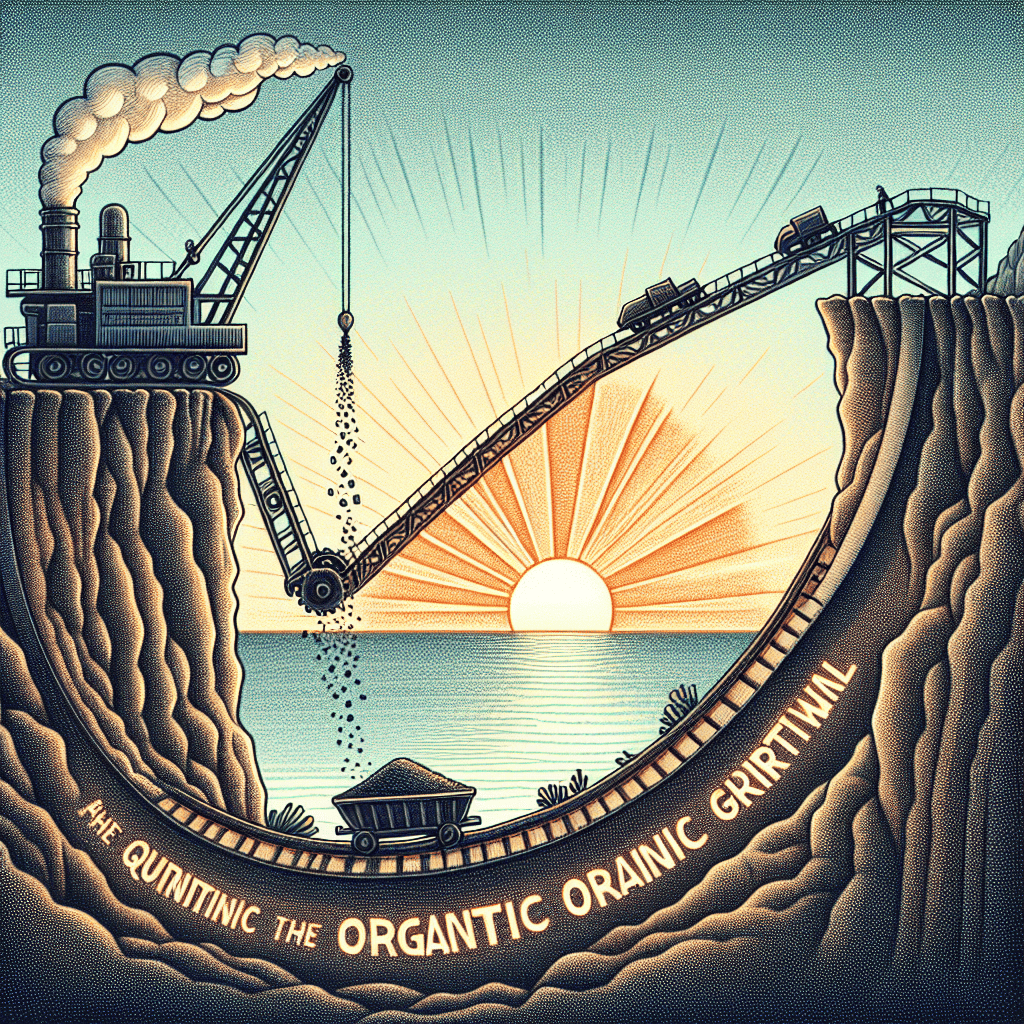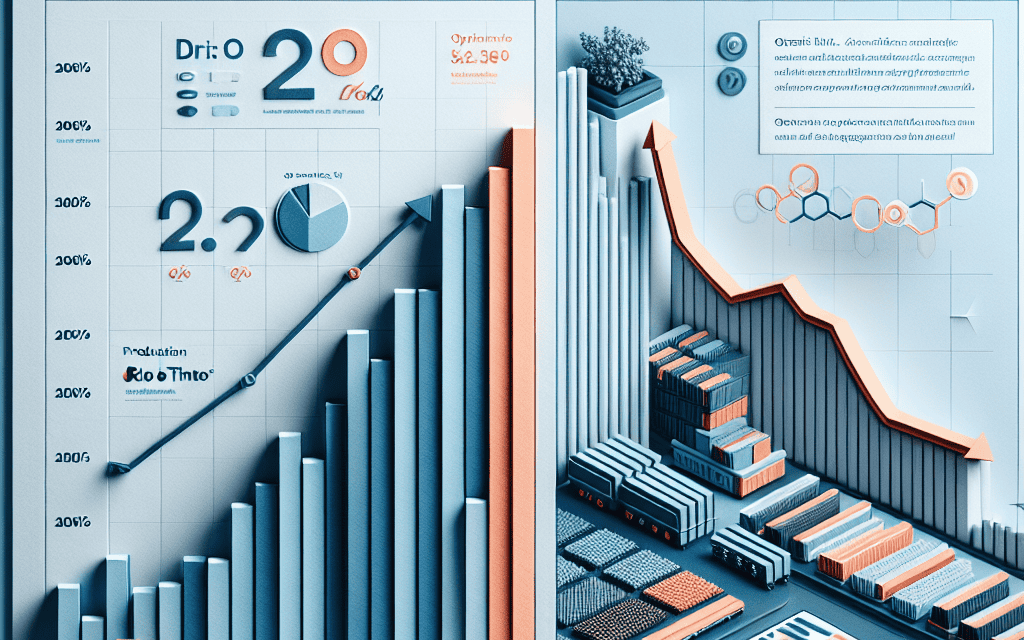“Rio Tinto’s Q3 Dip: Paving the Path for Promising Organic Growth Ahead”
Introduction
In the third quarter, Rio Tinto reported a decline in production, falling short of market expectations. Despite this setback, the company remains optimistic about its future, emphasizing a strong outlook for organic growth. Rio Tinto’s strategic focus on enhancing operational efficiency and investing in sustainable projects underpins its confidence in overcoming current challenges. The company is poised to leverage its robust portfolio and innovative practices to drive long-term value, ensuring resilience in a fluctuating market environment.
Analysis Of Rio Tinto’s Q3 Production Shortfall
In the third quarter of 2023, Rio Tinto, one of the world’s leading mining companies, reported a production shortfall that has captured the attention of industry analysts and investors alike. Despite the setback, the company remains optimistic about its prospects for organic growth, a sentiment that underscores its strategic focus on long-term sustainability and expansion. The production shortfall, primarily attributed to operational challenges and adverse weather conditions, has prompted a closer examination of Rio Tinto’s current strategies and future plans.
The company’s Q3 report revealed a decline in the output of key commodities, including iron ore, copper, and aluminum. This decline was largely due to unplanned maintenance activities and disruptions caused by inclement weather, which affected mining operations in several regions. For instance, heavy rainfall in Western Australia impacted iron ore production, while maintenance issues at the Kennecott mine in the United States led to reduced copper output. These factors combined to create a challenging quarter for Rio Tinto, as it struggled to meet its production targets.
However, despite these setbacks, Rio Tinto’s management remains confident in the company’s ability to achieve organic growth. This confidence is rooted in several strategic initiatives that the company has undertaken to enhance its operational efficiency and expand its resource base. One such initiative is the ongoing investment in technology and innovation, which aims to improve productivity and reduce costs across its operations. By leveraging advanced technologies such as automation and artificial intelligence, Rio Tinto seeks to optimize its mining processes and increase output in the long term.
Moreover, the company is actively pursuing opportunities to expand its resource portfolio through exploration and development projects. In particular, Rio Tinto has identified several high-potential sites for future mining operations, which are expected to contribute significantly to its production capacity in the coming years. These projects are not only aimed at increasing output but also at diversifying the company’s commodity mix, thereby reducing its reliance on any single resource and enhancing its resilience to market fluctuations.
In addition to these growth initiatives, Rio Tinto is also committed to sustainability and environmental stewardship, which are integral to its long-term strategy. The company has set ambitious targets to reduce its carbon footprint and increase the use of renewable energy in its operations. By aligning its growth objectives with sustainability goals, Rio Tinto aims to create value for its stakeholders while minimizing its environmental impact.
Furthermore, the company’s optimistic outlook is supported by favorable market conditions, particularly in the iron ore and copper sectors. Strong demand from emerging markets, coupled with supply constraints in certain regions, has led to favorable pricing dynamics for these commodities. This market environment provides a solid foundation for Rio Tinto to capitalize on its growth initiatives and achieve its production targets in the future.
In conclusion, while Rio Tinto’s Q3 production shortfall presents immediate challenges, the company’s strategic focus on organic growth and sustainability positions it well for long-term success. By investing in technology, expanding its resource base, and prioritizing environmental stewardship, Rio Tinto is poised to overcome current obstacles and deliver value to its stakeholders. As the company navigates these challenges, its commitment to innovation and sustainability will be key drivers of its future growth and resilience in the global mining industry.
Factors Contributing To Rio Tinto’s Q3 Performance
In the third quarter of 2023, Rio Tinto, one of the world’s leading mining companies, reported a decline in production, which has sparked discussions about the factors contributing to this performance. Despite the shortfall, the company remains optimistic about its potential for organic growth, driven by strategic initiatives and market dynamics. To understand the nuances of Rio Tinto’s Q3 performance, it is essential to examine the various elements that influenced the company’s output during this period.
One of the primary factors affecting Rio Tinto’s production in the third quarter was the operational challenges faced at several of its key mining sites. These challenges included equipment maintenance issues and unexpected disruptions in the supply chain, which collectively hampered the company’s ability to maintain its usual production levels. Additionally, adverse weather conditions in certain regions further exacerbated these operational difficulties, leading to temporary shutdowns and reduced output. Consequently, these disruptions played a significant role in the overall decline in production for the quarter.
Moreover, the global economic environment during this period also contributed to Rio Tinto’s performance. Fluctuations in commodity prices, driven by geopolitical tensions and shifting demand patterns, created an uncertain market landscape. This volatility impacted the company’s revenue streams and influenced its production strategies. In response, Rio Tinto adopted a cautious approach, prioritizing cost management and efficiency improvements to mitigate the effects of these external pressures. While this strategy helped stabilize the company’s financial position, it also resulted in a more conservative production outlook for the quarter.
Despite these challenges, Rio Tinto remains optimistic about its prospects for organic growth. The company has been investing in several strategic initiatives aimed at enhancing its long-term production capabilities. For instance, Rio Tinto has been focusing on expanding its presence in high-growth markets, such as lithium and copper, which are essential for the transition to a low-carbon economy. By capitalizing on the increasing demand for these critical minerals, the company aims to position itself as a key player in the global supply chain for sustainable technologies.
Furthermore, Rio Tinto’s commitment to innovation and technological advancement is expected to drive future growth. The company has been actively exploring the use of automation and digitalization to improve operational efficiency and reduce costs. These efforts are anticipated to enhance productivity and enable Rio Tinto to better navigate the complexities of the mining industry. As these technologies become more integrated into the company’s operations, they are likely to contribute positively to its production capabilities and overall performance.
In addition to these internal strategies, Rio Tinto is also benefiting from favorable market trends that support its growth ambitions. The ongoing global push towards decarbonization and sustainable development is expected to drive demand for the minerals and metals that Rio Tinto produces. This trend presents a significant opportunity for the company to leverage its expertise and resources to meet the evolving needs of the market.
In conclusion, while Rio Tinto’s Q3 production fell short of expectations due to a combination of operational challenges and external market factors, the company remains well-positioned for future growth. Through strategic investments in high-growth markets, a focus on innovation, and an alignment with global sustainability trends, Rio Tinto is poised to capitalize on emerging opportunities and enhance its production capabilities. As the company continues to navigate the complexities of the mining industry, its commitment to organic growth underscores its confidence in achieving long-term success.
Rio Tinto’s Strategic Plans For Organic Growth
In the third quarter of 2023, Rio Tinto, one of the world’s leading mining companies, reported a decline in production, a development that has captured the attention of industry analysts and stakeholders alike. Despite this setback, the company remains optimistic about its future, particularly in terms of organic growth. This optimism is rooted in a strategic plan that emphasizes sustainable development and long-term value creation, which Rio Tinto believes will position it favorably in the evolving global market.
The decline in production during the third quarter can be attributed to several factors, including operational challenges and external market conditions. For instance, adverse weather conditions in key mining regions and logistical disruptions have impacted output levels. Additionally, fluctuating commodity prices have posed challenges, affecting the company’s ability to maintain consistent production levels. However, Rio Tinto has demonstrated resilience in the face of these challenges, focusing on optimizing its existing operations and enhancing efficiency.
Transitioning from these immediate concerns, Rio Tinto’s strategic plans for organic growth are centered on leveraging its existing assets and capabilities. The company is committed to investing in technology and innovation to improve operational efficiency and reduce environmental impact. By adopting advanced mining technologies and digital solutions, Rio Tinto aims to enhance productivity and ensure sustainable resource management. This approach not only aligns with global sustainability goals but also positions the company as a leader in responsible mining practices.
Moreover, Rio Tinto is actively exploring opportunities to expand its portfolio through organic means. This involves identifying and developing new projects within its existing asset base, thereby minimizing the risks associated with acquisitions and mergers. The company is particularly focused on expanding its presence in the copper and lithium markets, which are critical for the transition to a low-carbon economy. By capitalizing on the growing demand for these essential minerals, Rio Tinto aims to secure a competitive edge in the market.
In addition to technological advancements and market expansion, Rio Tinto is also prioritizing stakeholder engagement and community development. The company recognizes that sustainable growth is not solely about financial performance but also about creating positive social and environmental impacts. To this end, Rio Tinto is working closely with local communities, governments, and other stakeholders to ensure that its operations contribute to regional development and prosperity. This collaborative approach is expected to foster goodwill and support for the company’s long-term growth initiatives.
Furthermore, Rio Tinto’s commitment to organic growth is underscored by its focus on talent development and workforce diversity. The company is investing in training and development programs to equip its employees with the skills needed to thrive in a rapidly changing industry. By fostering a diverse and inclusive workplace, Rio Tinto aims to drive innovation and creativity, which are essential for achieving sustainable growth.
In conclusion, while Rio Tinto’s third-quarter production figures may have fallen short of expectations, the company’s strategic plans for organic growth paint an optimistic picture for the future. By focusing on technology, market expansion, stakeholder engagement, and talent development, Rio Tinto is well-positioned to navigate the challenges of the mining industry and capitalize on emerging opportunities. As the company continues to implement its strategic initiatives, it remains committed to creating long-term value for its shareholders and contributing to a sustainable future.
Market Reactions To Rio Tinto’s Q3 Results

Rio Tinto’s third-quarter production results have sparked a wave of reactions across the market, as the mining giant reported figures that fell short of expectations. Despite the shortfall, the company has maintained an optimistic outlook for organic growth, which has intrigued investors and analysts alike. The production decline was primarily attributed to operational challenges and adverse weather conditions, which disrupted activities in key mining regions. These factors, while temporary, have raised questions about the company’s ability to meet its annual targets. However, Rio Tinto’s management has been quick to reassure stakeholders, emphasizing their commitment to overcoming these hurdles and focusing on long-term growth strategies.
In response to the production dip, market analysts have been closely examining Rio Tinto’s strategic plans for organic growth. The company has outlined several initiatives aimed at enhancing operational efficiency and expanding its resource base. These initiatives include investments in technology to improve mining processes and reduce costs, as well as exploration activities to identify new mineral deposits. By leveraging these strategies, Rio Tinto aims to strengthen its competitive position in the global mining industry and deliver sustainable value to shareholders.
Moreover, the company’s optimistic outlook is supported by favorable market conditions for key commodities such as iron ore, copper, and aluminum. Demand for these resources remains robust, driven by ongoing industrialization and infrastructure development in emerging economies. This demand is expected to provide a solid foundation for Rio Tinto’s growth ambitions, as the company seeks to capitalize on its extensive portfolio of high-quality assets. Additionally, Rio Tinto’s focus on sustainability and responsible mining practices has resonated well with investors who are increasingly prioritizing environmental, social, and governance (ESG) considerations in their investment decisions.
Despite the positive long-term prospects, the immediate market reaction to Rio Tinto’s Q3 results has been mixed. Some investors have expressed concerns about the potential impact of the production shortfall on the company’s financial performance in the near term. These concerns have been reflected in fluctuations in Rio Tinto’s stock price, as market participants weigh the risks and opportunities associated with the company’s current situation. However, others have taken a more optimistic view, interpreting the production challenges as temporary setbacks that do not detract from the company’s overall growth trajectory.
In light of these mixed reactions, it is evident that Rio Tinto’s ability to effectively communicate its growth strategy and address operational challenges will be crucial in shaping market sentiment. The company’s management has reiterated their commitment to transparency and accountability, providing regular updates on progress and engaging with stakeholders to address any concerns. This proactive approach is likely to instill confidence among investors and reinforce the company’s reputation as a leading player in the mining sector.
In conclusion, while Rio Tinto’s Q3 production results have fallen short of expectations, the company’s optimistic outlook for organic growth offers a compelling narrative for the future. By focusing on strategic initiatives and leveraging favorable market conditions, Rio Tinto is well-positioned to navigate the current challenges and deliver long-term value to its shareholders. As the company continues to execute its growth plans, market reactions will undoubtedly evolve, reflecting the dynamic interplay between short-term performance and long-term potential.
Future Prospects For Rio Tinto’s Production Capabilities
In the third quarter of 2023, Rio Tinto, one of the world’s leading mining companies, reported a decline in production, a development that has captured the attention of industry analysts and investors alike. Despite this setback, the company remains optimistic about its future prospects, particularly in terms of organic growth. This optimism is rooted in a strategic focus on enhancing operational efficiency and expanding its resource base, which are expected to bolster production capabilities in the coming years.
The recent dip in production can be attributed to several factors, including operational challenges and external market conditions. For instance, adverse weather conditions in key mining regions and logistical disruptions have played a significant role in hindering output. Additionally, fluctuating commodity prices have added a layer of complexity to the company’s production strategy. However, Rio Tinto has demonstrated resilience in the face of these challenges, leveraging its robust infrastructure and technological advancements to mitigate the impact on its overall performance.
Looking ahead, Rio Tinto’s commitment to organic growth is underscored by its investment in innovative technologies and sustainable practices. The company is actively exploring the integration of automation and digitalization across its operations, which is expected to enhance productivity and reduce costs. By harnessing the power of data analytics and artificial intelligence, Rio Tinto aims to optimize its mining processes, thereby increasing efficiency and output. This technological transformation is not only anticipated to improve production capabilities but also to align with the company’s sustainability goals, reducing its environmental footprint and promoting responsible mining practices.
Moreover, Rio Tinto’s strategic expansion into new resource areas is poised to support its growth ambitions. The company has identified several high-potential projects that are expected to contribute significantly to its production portfolio. These projects, which are in various stages of development, are strategically located in regions with rich mineral deposits and favorable regulatory environments. By diversifying its resource base, Rio Tinto is positioning itself to capitalize on emerging market opportunities and mitigate risks associated with over-reliance on specific commodities or geographies.
In addition to technological and geographical expansion, Rio Tinto is also focusing on strengthening its partnerships with local communities and governments. By fostering collaborative relationships, the company aims to ensure the long-term viability of its operations and secure the necessary support for its growth initiatives. This approach not only enhances Rio Tinto’s reputation as a responsible corporate citizen but also facilitates smoother project execution and community engagement.
While the recent production shortfall presents challenges, Rio Tinto’s strategic initiatives and forward-looking approach provide a solid foundation for future growth. The company’s emphasis on innovation, sustainability, and strategic expansion is expected to drive improvements in production capabilities, ultimately enhancing shareholder value. As Rio Tinto navigates the complexities of the global mining landscape, its focus on organic growth positions it well to adapt to changing market dynamics and capitalize on new opportunities.
In conclusion, Rio Tinto’s Q3 production decline serves as a reminder of the inherent challenges in the mining industry. However, the company’s proactive measures and strategic vision underscore its commitment to overcoming these obstacles and achieving sustainable growth. By investing in technology, expanding its resource base, and fostering strong community partnerships, Rio Tinto is poised to enhance its production capabilities and secure its position as a leader in the global mining sector.
Rio Tinto’s Investment In Sustainable Mining Practices
In the third quarter of 2023, Rio Tinto, one of the world’s leading mining companies, reported a decline in production, a development that has captured the attention of industry analysts and stakeholders alike. Despite this setback, the company remains optimistic about its future, particularly in terms of organic growth and sustainable mining practices. This dual focus on addressing immediate challenges while planning for long-term sustainability reflects a strategic approach that could redefine the mining sector’s landscape.
The decline in production during Q3 can be attributed to several factors, including operational disruptions and fluctuating market conditions. However, Rio Tinto has not allowed these challenges to overshadow its commitment to sustainable mining. The company has been investing heavily in innovative technologies and practices designed to minimize environmental impact and enhance resource efficiency. This commitment is evident in its ongoing efforts to reduce carbon emissions, manage water resources responsibly, and rehabilitate mining sites.
Transitioning from traditional mining methods to more sustainable practices is no small feat. It requires significant investment, not only in terms of capital but also in research and development. Rio Tinto has been at the forefront of this transition, pioneering initiatives that aim to set new industry standards. For instance, the company has been exploring the use of renewable energy sources to power its operations, thereby reducing its reliance on fossil fuels. Additionally, Rio Tinto is actively involved in developing technologies that enable the recycling of mining waste, turning potential environmental liabilities into valuable resources.
While the immediate focus may be on overcoming the production shortfall, Rio Tinto’s long-term vision is centered around organic growth. This involves expanding its resource base through exploration and development of new mining sites, as well as optimizing existing operations. The company’s strategy is underpinned by a belief that sustainable practices and organic growth are not mutually exclusive but rather complementary. By integrating sustainability into its growth plans, Rio Tinto aims to create value not only for its shareholders but also for the communities in which it operates.
Moreover, Rio Tinto’s commitment to sustainable mining is aligned with global trends and regulatory pressures. As governments and international bodies increasingly prioritize environmental sustainability, mining companies are under growing pressure to demonstrate their environmental stewardship. Rio Tinto’s proactive approach positions it well to meet these expectations and potentially gain a competitive advantage in the market.
In conclusion, while Rio Tinto’s Q3 production figures may have fallen short of expectations, the company’s focus on sustainable mining practices and organic growth offers a promising outlook. By investing in innovative technologies and aligning its operations with global sustainability goals, Rio Tinto is not only addressing current challenges but also paving the way for a more sustainable and profitable future. This strategic approach underscores the importance of balancing immediate operational needs with long-term environmental and social responsibilities, a balance that is increasingly crucial in today’s mining industry. As Rio Tinto continues to navigate these complex dynamics, its efforts could serve as a blueprint for other companies seeking to achieve sustainable growth in a rapidly evolving global landscape.
Comparing Rio Tinto’s Q3 Performance With Industry Peers
In the third quarter of 2023, Rio Tinto, one of the world’s leading mining companies, reported a decline in production, a development that has sparked considerable interest among industry analysts and investors alike. This downturn in output, while concerning on the surface, is part of a broader narrative that includes both challenges and opportunities for the company. When compared to its industry peers, Rio Tinto’s performance offers a unique perspective on the current state of the mining sector and its future prospects.
To begin with, Rio Tinto’s Q3 production figures revealed a decrease in the output of key commodities such as iron ore, copper, and aluminum. This decline can be attributed to several factors, including operational disruptions, adverse weather conditions, and ongoing geopolitical tensions that have affected supply chains globally. In contrast, some of Rio Tinto’s competitors, such as BHP and Vale, have managed to maintain or even increase their production levels during the same period. This disparity highlights the varying strategies and operational efficiencies employed by different companies within the industry.
Despite the shortfall in production, Rio Tinto remains optimistic about its long-term growth prospects. The company has emphasized its commitment to organic growth, focusing on expanding its existing operations and investing in new projects. This strategy is particularly evident in its efforts to develop the Simandou iron ore project in Guinea, which is expected to significantly boost its production capacity in the coming years. By prioritizing organic growth, Rio Tinto aims to enhance its competitive position and capitalize on the anticipated increase in global demand for minerals driven by the transition to a low-carbon economy.
Moreover, Rio Tinto’s focus on sustainability and innovation sets it apart from many of its peers. The company has been actively investing in technologies that reduce carbon emissions and improve resource efficiency. For instance, its ELYSIS joint venture aims to develop a breakthrough technology for producing aluminum without direct greenhouse gas emissions. Such initiatives not only align with global sustainability goals but also position Rio Tinto as a leader in the industry’s shift towards more environmentally responsible practices.
In comparison, while some of Rio Tinto’s competitors have also made strides in sustainability, the pace and scale of their initiatives vary. Companies like Anglo American and Glencore have announced ambitious targets for reducing their carbon footprints, yet the implementation of these goals remains a work in progress. This divergence in sustainability efforts underscores the different approaches companies are taking to address environmental challenges and meet stakeholder expectations.
Furthermore, Rio Tinto’s financial health remains robust, providing a solid foundation for its growth ambitions. The company has maintained a strong balance sheet, which allows it to invest in strategic projects and weather short-term fluctuations in commodity prices. This financial stability is a critical advantage, especially when compared to some industry peers that may face constraints due to higher debt levels or less diversified portfolios.
In conclusion, while Rio Tinto’s Q3 production figures may have fallen short of expectations, the company’s strategic focus on organic growth and sustainability offers a promising outlook. By leveraging its strengths and addressing current challenges, Rio Tinto is well-positioned to navigate the evolving landscape of the mining industry. As the sector continues to adapt to changing market dynamics and environmental imperatives, Rio Tinto’s performance relative to its peers will be a key indicator of its ability to achieve long-term success.
Q&A
1. **What was the main reason for Rio Tinto’s Q3 production shortfall?**
– The production shortfall was primarily due to operational challenges and adverse weather conditions affecting key mining sites.
2. **Which commodities were most affected by the production decline?**
– Iron ore and copper were among the commodities most affected by the production decline.
3. **How did Rio Tinto’s Q3 production compare to market expectations?**
– Rio Tinto’s Q3 production fell short of market expectations, leading to a reassessment of output forecasts.
4. **What measures is Rio Tinto taking to address the production issues?**
– Rio Tinto is implementing operational improvements and investing in technology to enhance efficiency and mitigate future disruptions.
5. **What is the company’s outlook for organic growth despite the Q3 shortfall?**
– The company remains optimistic about its long-term organic growth prospects, driven by strategic investments and expansion projects.
6. **How has the market reacted to Rio Tinto’s Q3 production report?**
– The market reaction was mixed, with some investors concerned about short-term performance, while others focused on the positive long-term growth outlook.
7. **What are some of the key projects contributing to Rio Tinto’s future growth?**
– Key projects include the development of the Oyu Tolgoi copper mine in Mongolia and the expansion of iron ore operations in the Pilbara region.
Conclusion
In Q3, Rio Tinto reported a decline in production, which fell short of expectations. Despite this setback, the company maintains an optimistic outlook for future organic growth. This positive perspective is driven by strategic investments and initiatives aimed at enhancing operational efficiency and expanding capacity. Rio Tinto’s focus on sustainable practices and innovation is expected to support long-term growth, positioning the company to capitalize on emerging market opportunities and increasing demand for its products.





